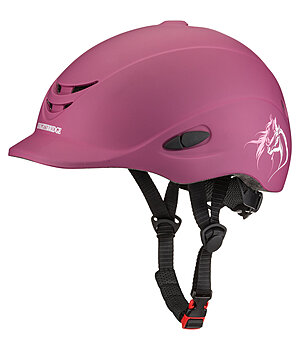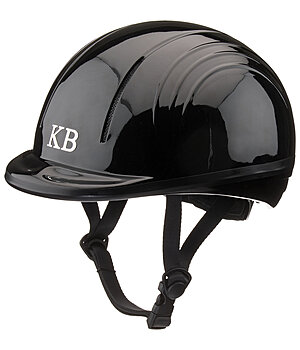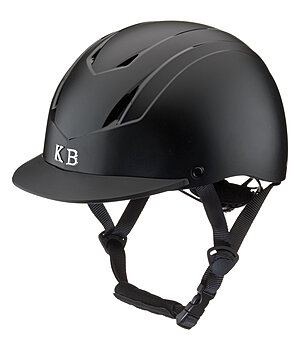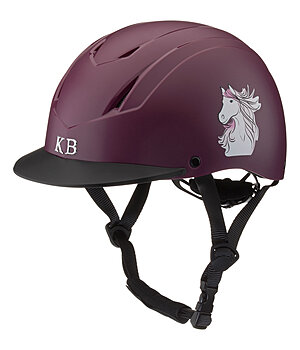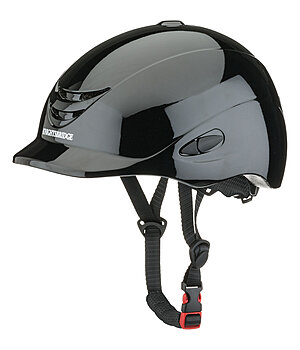Children’s Riding Hat Guide
Whether it is for riding lessons, for a ride with your own pony or for ground work – wearing suitable head protection is a necessity, that is no longer associated with compromises in terms of comfort or appearance. A good children’s riding hat that meets the current safety standard is available in a wide range of sizes and starts at £ 30.

1. A children’s riding hat should have the following characteristics.
The primary aim of a children’s riding hat must be to provide maximum protection in the event of a fall or kick from a horse.
All our riding hats for children comply with the currently valid riding helmet standard EN1384:2023.
Only when the chosen riding hat meets these criteria should you think about the colour of the outer shell and the design. We have summarised the most important criteria regarding safety, functionality, comfort and design for you in our guide to children’s riding hats.

A riding hat for children should meet the following profile:
- Provides impact and shock protection as well as cushioning in the event of a fall or impact.
- Protects against serious injury in the event of a kick from a horse.
- Provides air circulation through integrated ventilation systems to prevent heat accumulation under the riding hat.
- Ideally, the hat „grows with you“ thanks to special size adjustment systems.
The 4 most important features of a children’s riding hat
In order to provide your child with both safety and the best possible comfort, the riding hat model should be both shock-absorbing and impact-resistant, as well as breathable. All models in our range support these properties thanks to sophisticated technical constructions, precisely processed materials as well as innovative features such as individual, infinitely variable size adjustment and fine adjustment.

1. Safety
Safety comes when riding, and children should learn this from their very first riding lesson. In addition to safe handling of the horse, safety should also be prioritised when buying riding equipment. The established safety standards are a great help and orientation when buying. Riding hats are subjected to strict testing and certified with the current riding hat standard EN1384:2023.
Another safety feature is the CE seal, which confirms that the riding hat complies with the applicable regulations.
2. Fit & size adjustment
Did you know that head growth is not complete until between the ages of 16 and 18? While head circumference increases a lot in the first three years of life, the growth rate flattens out after that. From the age of three, we assume an annual head growth of between 0.3 cm and 1 cm. Even if the changes seem minimal, children should be checked regularly to see if their riding hat still fits.

The riding hat is too big if it:
- When opened, it moves a lot on the head when moving backwards and forwards
- Falls off the head when leaning forward
- Slips too far down the face
The helmet is too small if:
- The 3-point harness does not fit around the ear and the straps cut into the ear
- There is an unpleasant feeling of pressure when putting on the riding hat
- The hat sits too far back and does not cover the forehead sufficiently
Ideally, a children’s riding hat should be adjustable. The adjustment options allow the riding hat to be individually adapted to the circumference of the head and enables the head protection to „grow with the child“, at least for some time. When buying, choose the smallest possible size.

3. Ventilation & comfort
In addition to safety, a child’s riding hat must be comfortable to wear. If the riding hat pinches and squeezes every now and then or the child is left with sweaty hair after the lesson, he or she will not be happy with their riding hat in the long term. The importance of an all-around comfortable children’s riding hat should not be underestimated. If the child associates positive experiences and characteristics with the riding hat from the very first riding lesson, he or she will wear it reliably and accept it as an essential part of a complete riding outfit.
Comfort is defined by the following criteria:
- Fit
When buying a riding hat, you make sure that it fits the respective head shape and that it sits comfortably.
- Weight
Heavy riding hats are a thing of the past. Since children are still growing, their neck muscles are not yet as developed as those of adults. Therefore, especially with children’s riding hats, the manufacturers pay attention to particularly light constructions in order to keep the weight as low as possible. However, always under the requirement of maximum protection! A heavier riding hat does not necessarily mean a higher level of protection. In addition, the weight of the children’s riding hat should be evenly distributed, so that on the one hand the neck region is relieved and on the other hand one-sided strain is counteracted. A lightweight children’s riding hat is characterised by both comfort and a high level of protection – provided that the fit is right.
- Ventilation
Riding is a sweaty sport, regardless of the season. While damp or even sweaty hair can hardly be avoided during physical activity in high summer, this circumstance can cause a cold feeling in winter, which is not only extremely unpleasant, but can also promote the development of colds, as the nasal and throat mucous membranes are less well supplied with blood and offer free passage to viruses and bacteria. Children’s riding hats are therefore equipped with sufficient ventilation slits to improve air circulation under the riding hat.
- Lining
A riding hat only becomes truly comfortable and suitable for wearing when it has the right inner lining. Many children are sensitive to pressure or chafing points, so when buying a children’s riding hat, the quality of the lining in particular should be evaluated. Washable, temperature-regulating and breathable are the properties that every lining should have.
For most models, the lining is also available as a replacement part. If it is lost or already worn out due to the duration of use, it is worthwhile to replace it regularly.
4. Appearance and design
Children love colourful designs and are often influenced by an eye-catching look. It is important to note: when buying a children’s riding hat, the look should always come third after safety and wearing comfort.
However, a child-friendly design also has advantages: if the child likes the riding hat, he or she will be happy to wear it. Therefore, be sure to involve your child when buying a riding hat.

2. How do I determine the right riding hat size?

The principle for determining the correct riding hat size for children is the same as for adults. Measure the head circumference at the widest part of the head. This measurement will give you an initial guide to choosing the right riding hat size. Since a well-fitting riding helmet depends not only on the head circumference but also on the individual head shape, the riding hats in question should definitely be tried on.
Learn more3. What safety standards must a riding hat for children meet?
The safety of one’s own child is the top priority for all parents; which in some cases can certainly lead to an inner conflict when the child decides to take up horse riding as a favoured hobby. Riding has many advantages, e.g. it prevents posture problems, trains almost all muscle groups, provides an excellent awareness of the body and balance and also promotes the child’s social awareness. Nevertheless, the popular hobby also comes with risks. Falls from a horse can cause head injuries – in the most frequent cases craniocerebral trauma. Due to the greater head-to-body ratio, the rate of head injuries in children under 14 is up to 38% higher than in adults. Serious injuries can be prevented by proper training of rider and horse, and especially by making riding hats compulsory.
But how do parents find out which is the safest riding hat for their own child?
In short, all riding hat models that go on sale have to undergo intensive testing in order to comply with the current riding hat standard. The criteria for this are constantly being updated and expanded. When you buy a riding hat from our range, we guarantee that all models comply with the current standard and are certified.
6 aspects you should definitely pay attention to after buying a riding hat:
#1 After a few years, the children’s riding hat should be replaced regardless of whether the child has fallen with it or not (usually he or she grows out of the riding hat) during this time anyway. In addition to the intensity of use, external influences such as sunlight or temperature of storage can reduce the protective effect of the EPS foam of the inner shell.
#2 After a fall, the riding hat must be replaced immediately. Even the smallest cracks caused by the fall can reduce the protection.
#3 Make your child aware of the need to be careful with the riding hat. If he or she drops the hat on the ground, for example, this can also lead to cracks in the hat.
#4 Store the riding hat in a cool, dry and dark place. The car is definitely the wrong place to store a riding hat.
#5 Children come up with all sorts of ideas. There are numerous DIY videos circulating on the internet on how to make your riding hat sparkle with Swarovski stones and a hot glue gun. Glue, paints – even supposedly harmless stickers – and other chemical agents can make the material brittle and damage it. Make sure that the helmet remains intact and only use approved accessories and spare parts from the manufacturer.
#6 Maintain the riding hat regularly with a soft cloth and a mild detergent. Harsh chemicals can destroy the material! Storing it in a helmet bag protects it from dirt and dust.
Certified children’s riding helmets from Knightsbridge
4. Can I also buy a used children’s riding hat?

If you want to save money, you usually look around for second-hand. However, is this really a good idea for a children’s riding hat?
While it is really no problem to fall back on used goods in good condition when it comes to second-hand riding clothes, this poses a considerable safety risk when it comes to riding hats. How old is the riding hat really? Did the previous owner fall with it? How did he handle it and how was the riding hat stored? These are all questions that are relevant for safety and often cannot be clarified with a used riding hat. Therefore, we advise against buying a used riding hat.
A new children’s riding hat does not have to be expensive either. In our online shop, the beginner model is already available from £26.90 and meets the current safety standards.
5. Can my child also ride with a bicycle helmet?
We can say a clear no to this. A fall from a horse is usually different from a fall from a bicycle. From a bicycle, one falls forwards in most cases, which is why the focus of helmet designs is primarily on the forehead and front of the head. If a rider falls off a horse, he or she often hits the side or even the back of the head. Therefore, riding hats are also designed on the side and back of the head so that a fall can be cushioned by the hat in any case.

A bicycle helmet cannot withstand the force of a horse’s hoof because of its lightweight construction. Another danger is the ventilation holes on a bicycle helmet, which are not as well protected as on a riding hat. A branch can quickly get caught in the ventilation holes during a ride and pull the child off the horse. The ventilation holes of riding helmets are usually additionally equipped with a protective grid or are smaller so that it is not possible to get caught.




